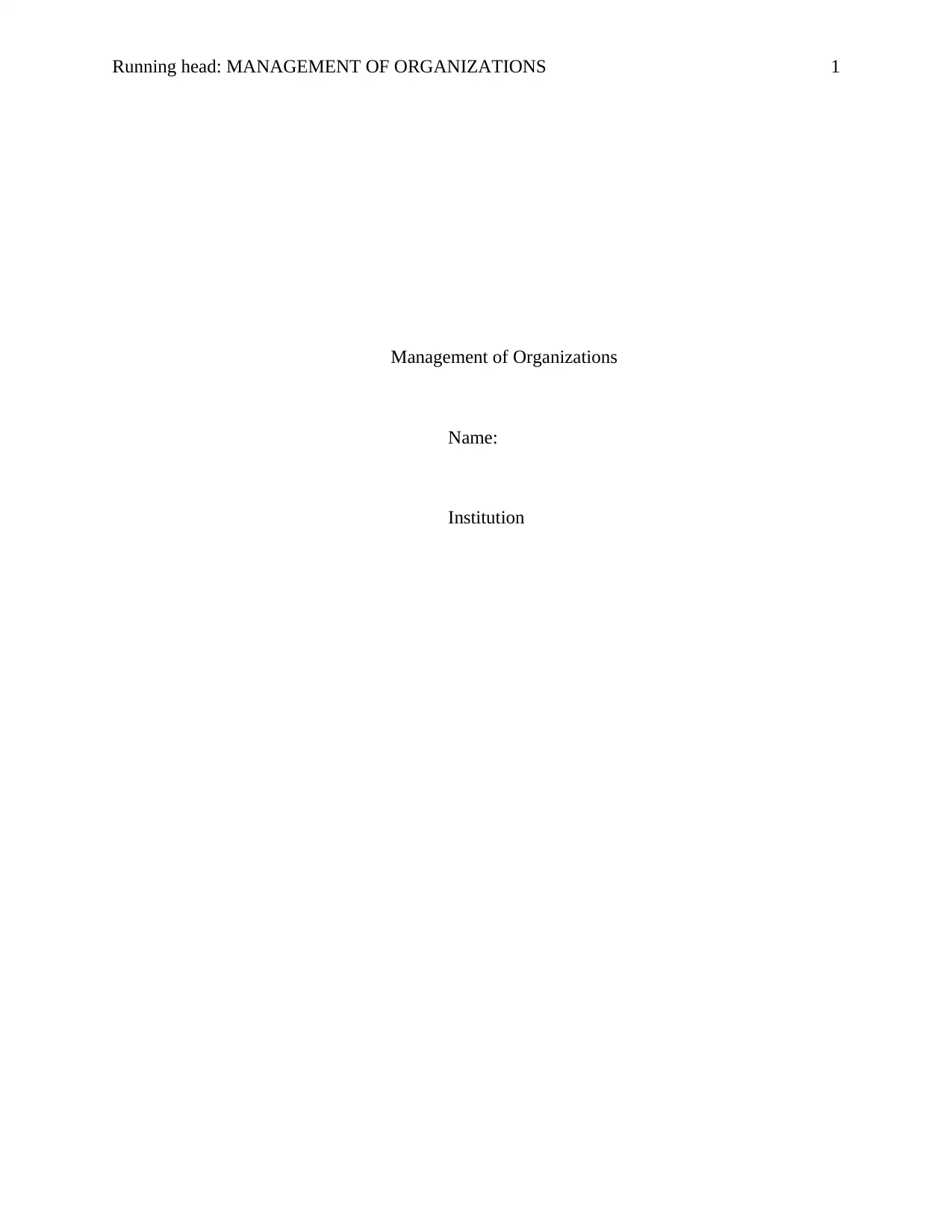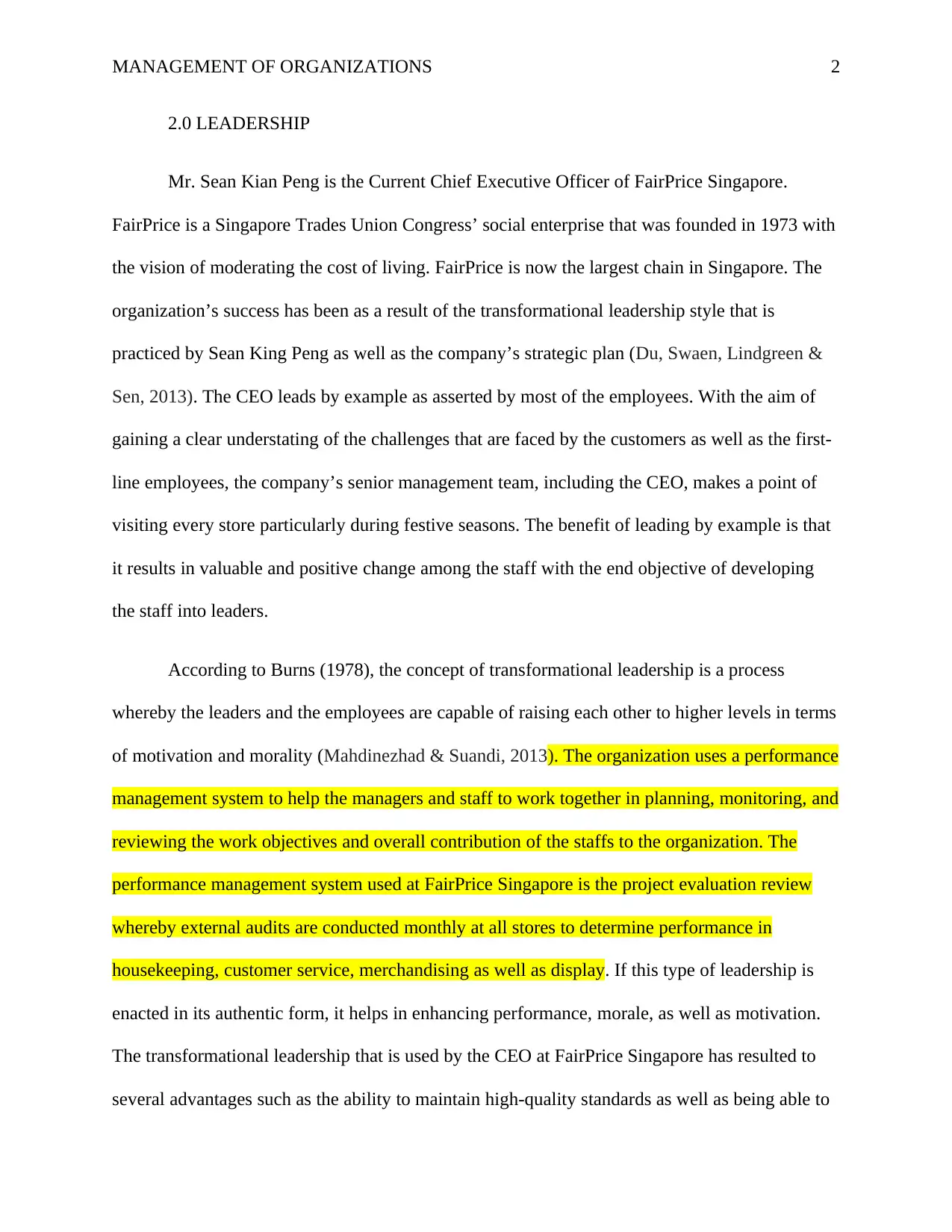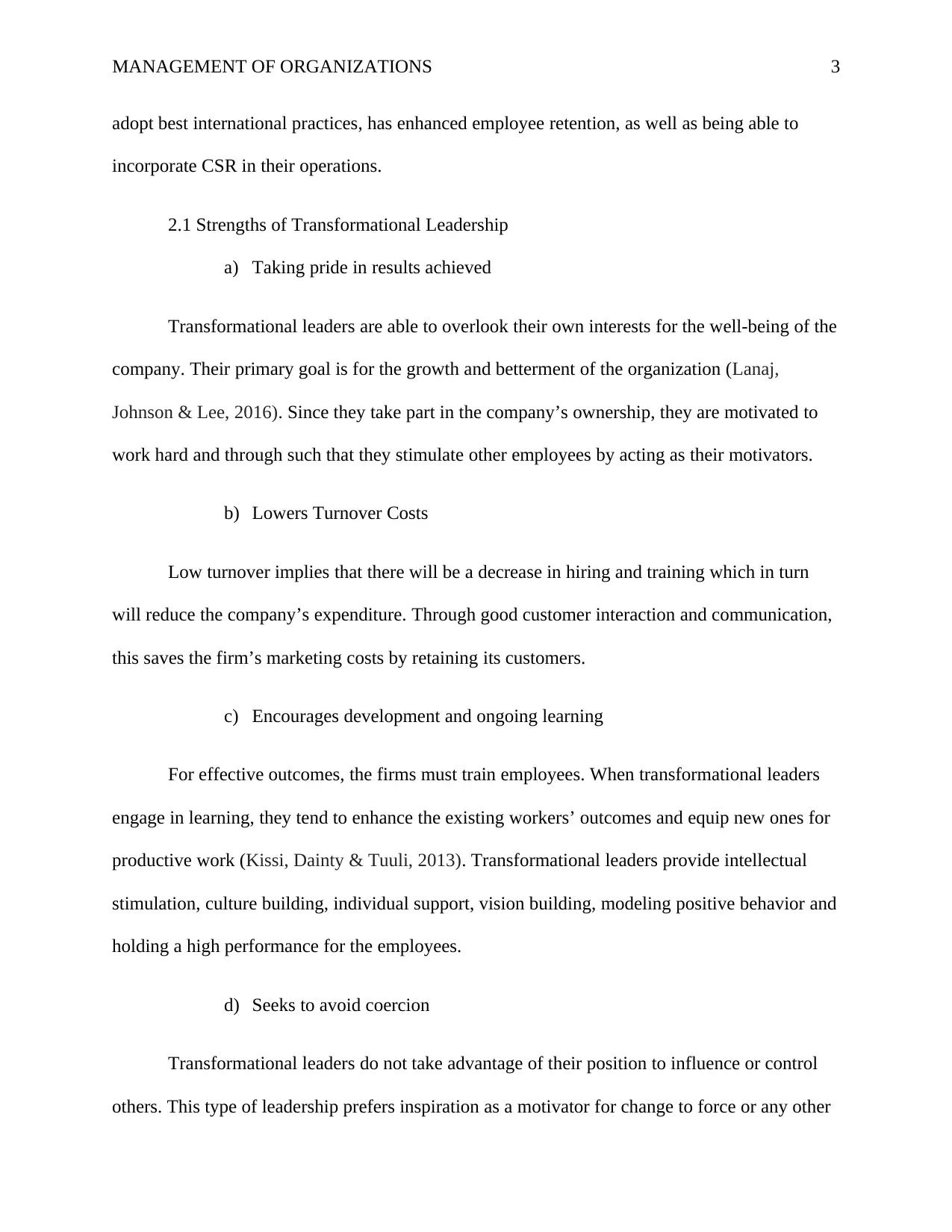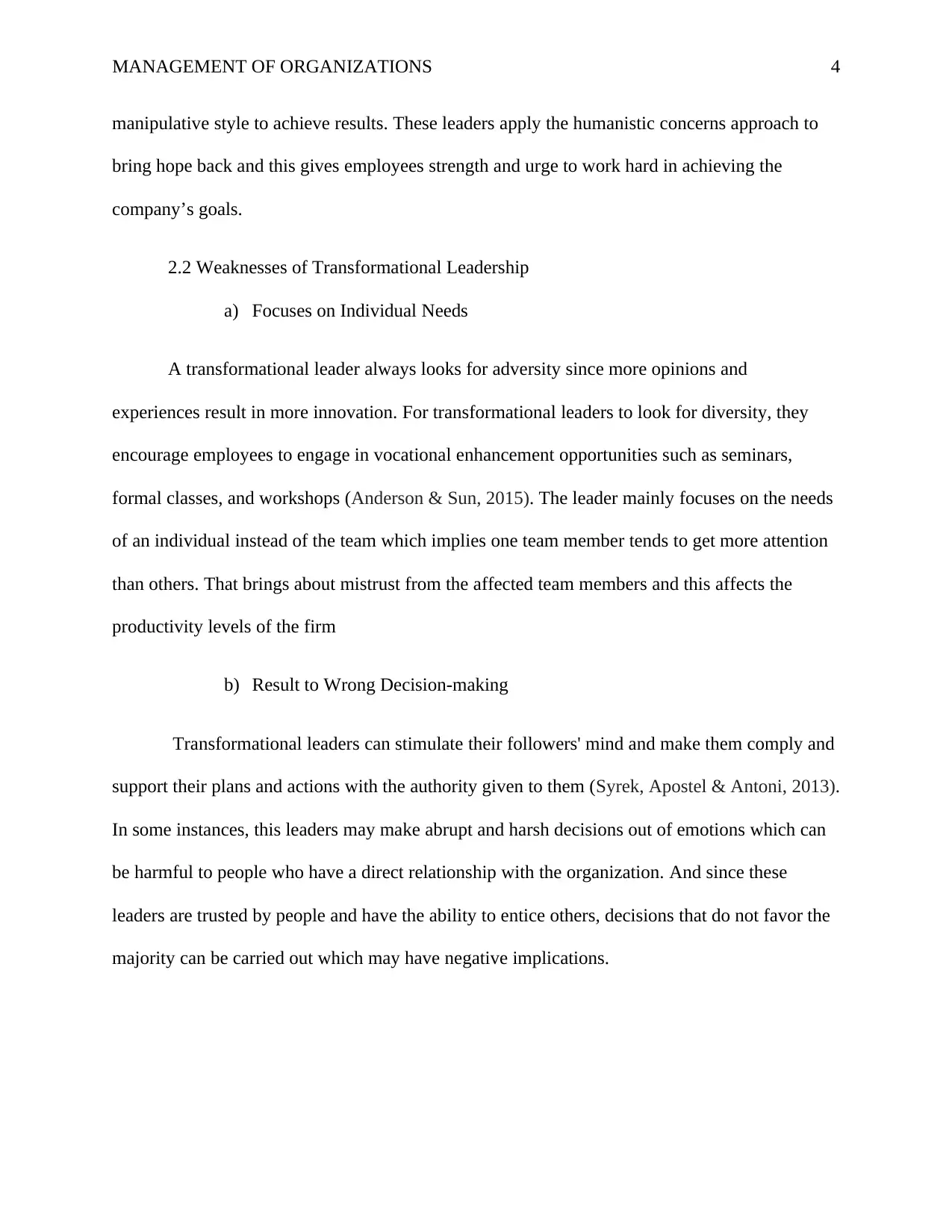Analyzing Leadership and Management at FairPrice Singapore
VerifiedAdded on 2023/06/05
|5
|1153
|79
Essay
AI Summary
This essay provides an analysis of the transformational leadership style employed by Mr. Sean Kian Peng, the CEO of FairPrice Singapore, and its impact on the organization. FairPrice, a social enterprise founded in 1973, has become the largest chain in Singapore due to its strategic plan and the CEO's leadership by example. The essay discusses the company's performance management system, which involves monthly external audits to assess performance in various areas. It highlights the advantages of transformational leadership, such as maintaining high-quality standards, enhancing employee retention, and incorporating CSR. The essay also examines the weaknesses, including a focus on individual needs and the potential for wrong decision-making. The analysis concludes by emphasizing the importance of authentic transformational leadership in enhancing performance, morale, and motivation within the organization.

Running head: MANAGEMENT OF ORGANIZATIONS 1
Management of Organizations
Name:
Institution
Management of Organizations
Name:
Institution
Paraphrase This Document
Need a fresh take? Get an instant paraphrase of this document with our AI Paraphraser

MANAGEMENT OF ORGANIZATIONS 2
2.0 LEADERSHIP
Mr. Sean Kian Peng is the Current Chief Executive Officer of FairPrice Singapore.
FairPrice is a Singapore Trades Union Congress’ social enterprise that was founded in 1973 with
the vision of moderating the cost of living. FairPrice is now the largest chain in Singapore. The
organization’s success has been as a result of the transformational leadership style that is
practiced by Sean King Peng as well as the company’s strategic plan (Du, Swaen, Lindgreen &
Sen, 2013). The CEO leads by example as asserted by most of the employees. With the aim of
gaining a clear understating of the challenges that are faced by the customers as well as the first-
line employees, the company’s senior management team, including the CEO, makes a point of
visiting every store particularly during festive seasons. The benefit of leading by example is that
it results in valuable and positive change among the staff with the end objective of developing
the staff into leaders.
According to Burns (1978), the concept of transformational leadership is a process
whereby the leaders and the employees are capable of raising each other to higher levels in terms
of motivation and morality (Mahdinezhad & Suandi, 2013). The organization uses a performance
management system to help the managers and staff to work together in planning, monitoring, and
reviewing the work objectives and overall contribution of the staffs to the organization. The
performance management system used at FairPrice Singapore is the project evaluation review
whereby external audits are conducted monthly at all stores to determine performance in
housekeeping, customer service, merchandising as well as display. If this type of leadership is
enacted in its authentic form, it helps in enhancing performance, morale, as well as motivation.
The transformational leadership that is used by the CEO at FairPrice Singapore has resulted to
several advantages such as the ability to maintain high-quality standards as well as being able to
2.0 LEADERSHIP
Mr. Sean Kian Peng is the Current Chief Executive Officer of FairPrice Singapore.
FairPrice is a Singapore Trades Union Congress’ social enterprise that was founded in 1973 with
the vision of moderating the cost of living. FairPrice is now the largest chain in Singapore. The
organization’s success has been as a result of the transformational leadership style that is
practiced by Sean King Peng as well as the company’s strategic plan (Du, Swaen, Lindgreen &
Sen, 2013). The CEO leads by example as asserted by most of the employees. With the aim of
gaining a clear understating of the challenges that are faced by the customers as well as the first-
line employees, the company’s senior management team, including the CEO, makes a point of
visiting every store particularly during festive seasons. The benefit of leading by example is that
it results in valuable and positive change among the staff with the end objective of developing
the staff into leaders.
According to Burns (1978), the concept of transformational leadership is a process
whereby the leaders and the employees are capable of raising each other to higher levels in terms
of motivation and morality (Mahdinezhad & Suandi, 2013). The organization uses a performance
management system to help the managers and staff to work together in planning, monitoring, and
reviewing the work objectives and overall contribution of the staffs to the organization. The
performance management system used at FairPrice Singapore is the project evaluation review
whereby external audits are conducted monthly at all stores to determine performance in
housekeeping, customer service, merchandising as well as display. If this type of leadership is
enacted in its authentic form, it helps in enhancing performance, morale, as well as motivation.
The transformational leadership that is used by the CEO at FairPrice Singapore has resulted to
several advantages such as the ability to maintain high-quality standards as well as being able to

MANAGEMENT OF ORGANIZATIONS 3
adopt best international practices, has enhanced employee retention, as well as being able to
incorporate CSR in their operations.
2.1 Strengths of Transformational Leadership
a) Taking pride in results achieved
Transformational leaders are able to overlook their own interests for the well-being of the
company. Their primary goal is for the growth and betterment of the organization (Lanaj,
Johnson & Lee, 2016). Since they take part in the company’s ownership, they are motivated to
work hard and through such that they stimulate other employees by acting as their motivators.
b) Lowers Turnover Costs
Low turnover implies that there will be a decrease in hiring and training which in turn
will reduce the company’s expenditure. Through good customer interaction and communication,
this saves the firm’s marketing costs by retaining its customers.
c) Encourages development and ongoing learning
For effective outcomes, the firms must train employees. When transformational leaders
engage in learning, they tend to enhance the existing workers’ outcomes and equip new ones for
productive work (Kissi, Dainty & Tuuli, 2013). Transformational leaders provide intellectual
stimulation, culture building, individual support, vision building, modeling positive behavior and
holding a high performance for the employees.
d) Seeks to avoid coercion
Transformational leaders do not take advantage of their position to influence or control
others. This type of leadership prefers inspiration as a motivator for change to force or any other
adopt best international practices, has enhanced employee retention, as well as being able to
incorporate CSR in their operations.
2.1 Strengths of Transformational Leadership
a) Taking pride in results achieved
Transformational leaders are able to overlook their own interests for the well-being of the
company. Their primary goal is for the growth and betterment of the organization (Lanaj,
Johnson & Lee, 2016). Since they take part in the company’s ownership, they are motivated to
work hard and through such that they stimulate other employees by acting as their motivators.
b) Lowers Turnover Costs
Low turnover implies that there will be a decrease in hiring and training which in turn
will reduce the company’s expenditure. Through good customer interaction and communication,
this saves the firm’s marketing costs by retaining its customers.
c) Encourages development and ongoing learning
For effective outcomes, the firms must train employees. When transformational leaders
engage in learning, they tend to enhance the existing workers’ outcomes and equip new ones for
productive work (Kissi, Dainty & Tuuli, 2013). Transformational leaders provide intellectual
stimulation, culture building, individual support, vision building, modeling positive behavior and
holding a high performance for the employees.
d) Seeks to avoid coercion
Transformational leaders do not take advantage of their position to influence or control
others. This type of leadership prefers inspiration as a motivator for change to force or any other
⊘ This is a preview!⊘
Do you want full access?
Subscribe today to unlock all pages.

Trusted by 1+ million students worldwide

MANAGEMENT OF ORGANIZATIONS 4
manipulative style to achieve results. These leaders apply the humanistic concerns approach to
bring hope back and this gives employees strength and urge to work hard in achieving the
company’s goals.
2.2 Weaknesses of Transformational Leadership
a) Focuses on Individual Needs
A transformational leader always looks for adversity since more opinions and
experiences result in more innovation. For transformational leaders to look for diversity, they
encourage employees to engage in vocational enhancement opportunities such as seminars,
formal classes, and workshops (Anderson & Sun, 2015). The leader mainly focuses on the needs
of an individual instead of the team which implies one team member tends to get more attention
than others. That brings about mistrust from the affected team members and this affects the
productivity levels of the firm
b) Result to Wrong Decision-making
Transformational leaders can stimulate their followers' mind and make them comply and
support their plans and actions with the authority given to them (Syrek, Apostel & Antoni, 2013).
In some instances, this leaders may make abrupt and harsh decisions out of emotions which can
be harmful to people who have a direct relationship with the organization. And since these
leaders are trusted by people and have the ability to entice others, decisions that do not favor the
majority can be carried out which may have negative implications.
manipulative style to achieve results. These leaders apply the humanistic concerns approach to
bring hope back and this gives employees strength and urge to work hard in achieving the
company’s goals.
2.2 Weaknesses of Transformational Leadership
a) Focuses on Individual Needs
A transformational leader always looks for adversity since more opinions and
experiences result in more innovation. For transformational leaders to look for diversity, they
encourage employees to engage in vocational enhancement opportunities such as seminars,
formal classes, and workshops (Anderson & Sun, 2015). The leader mainly focuses on the needs
of an individual instead of the team which implies one team member tends to get more attention
than others. That brings about mistrust from the affected team members and this affects the
productivity levels of the firm
b) Result to Wrong Decision-making
Transformational leaders can stimulate their followers' mind and make them comply and
support their plans and actions with the authority given to them (Syrek, Apostel & Antoni, 2013).
In some instances, this leaders may make abrupt and harsh decisions out of emotions which can
be harmful to people who have a direct relationship with the organization. And since these
leaders are trusted by people and have the ability to entice others, decisions that do not favor the
majority can be carried out which may have negative implications.
Paraphrase This Document
Need a fresh take? Get an instant paraphrase of this document with our AI Paraphraser

MANAGEMENT OF ORGANIZATIONS 5
References
Anderson, M. H., & Sun, P. Y. (2015). The downside of transformational leadership when
encouraging followers to network. The Leadership Quarterly, 26(5), 790-801.
Du, S., Swaen, V., Lindgreen, A., & Sen, S. (2013). The roles of leadership styles in corporate
social responsibility. Journal of business ethics, 114(1), 155-169.
Kissi, J., Dainty, A., & Tuuli, M. (2013). Examining the role of transformational leadership of
portfolio managers in project performance. International Journal of project
management, 31(4), 485-497.
Lanaj, K., Johnson, R. E., & Lee, S. M. (2016). Benefits of transformational behaviors for
leaders: A daily investigation of leader behaviors and need fulfillment. Journal of
Applied Psychology, 101(2), 237.
Mahdinezhad, M., & Suandi, B. (2013). Transformational, Transactional Leadership Styles and
Job Performance of Academic Leaders. International Education Studies, 6(11), 29-34.
Syrek, C. J., Apostel, E., & Antoni, C. H. (2013). Stress in highly demanding IT jobs:
Transformational leadership moderates the impact of time pressure on exhaustion and
work–life balance. Journal of Occupational Health Psychology, 18(3), 252.
References
Anderson, M. H., & Sun, P. Y. (2015). The downside of transformational leadership when
encouraging followers to network. The Leadership Quarterly, 26(5), 790-801.
Du, S., Swaen, V., Lindgreen, A., & Sen, S. (2013). The roles of leadership styles in corporate
social responsibility. Journal of business ethics, 114(1), 155-169.
Kissi, J., Dainty, A., & Tuuli, M. (2013). Examining the role of transformational leadership of
portfolio managers in project performance. International Journal of project
management, 31(4), 485-497.
Lanaj, K., Johnson, R. E., & Lee, S. M. (2016). Benefits of transformational behaviors for
leaders: A daily investigation of leader behaviors and need fulfillment. Journal of
Applied Psychology, 101(2), 237.
Mahdinezhad, M., & Suandi, B. (2013). Transformational, Transactional Leadership Styles and
Job Performance of Academic Leaders. International Education Studies, 6(11), 29-34.
Syrek, C. J., Apostel, E., & Antoni, C. H. (2013). Stress in highly demanding IT jobs:
Transformational leadership moderates the impact of time pressure on exhaustion and
work–life balance. Journal of Occupational Health Psychology, 18(3), 252.
1 out of 5
Related Documents
Your All-in-One AI-Powered Toolkit for Academic Success.
+13062052269
info@desklib.com
Available 24*7 on WhatsApp / Email
![[object Object]](/_next/static/media/star-bottom.7253800d.svg)
Unlock your academic potential
Copyright © 2020–2025 A2Z Services. All Rights Reserved. Developed and managed by ZUCOL.





